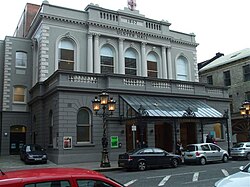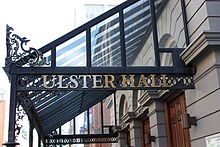Ulster Hall
 | |
 | |
 | |
| Location | Bedford Street Belfast Northern Ireland |
|---|---|
| Coordinates | 54°35′39.5″N 5°55′51″W / 54.594306°N 5.93083°W |
| Owner | Belfast City Council |
| Type | Concert hall |
| Capacity | 1,000 seated, or 1,850 standing |
| Construction | |
| Built | 1859 |
| Opened | 1862 |
| Renovated | 2009 |
| Website | |
| www.ulsterhall.co.uk | |
Ulster Hall is a concert hall and grade B1 listed building in Belfast, Northern Ireland. Situated on Bedford Street in Belfast city centre, the hall hosts concerts, classical recitals, craft fairs and political party conferences. Despite the opening of larger concert halls in the city, such as the Waterfront Hall and the Odyssey, the Ulster Hall has remained a very popular venue, and is considered to evoke much more atmosphere than the newer venues.[citation needed]
History

Built in 1859 and opened in 1862,[1] the hall's purpose was to provide the expanding city of Belfast with a multi-purpose venue of sufficient size. It was designed by William J. Barre (also responsible for the Albert Clock) for the Ulster Hall Company.
On its opening night on 12 May 1862, the hall was described by the local press as:
stand[ing] unexcelled, and all but unrivalled, as an edifice for the production of musical works. ... the hall is a great and unmingled success, and the public, no less than the proprietors, may feel the utmost gratification at a result at once so pleasant and so rare.(The Belfast News Letter, 1862)[2]
a music hall fit for the production of any composition, and for the reception of any artist, however eminent (The Northern Whig, 14 May 1862)[3]
In 1902 the hall was purchased by Belfast City Council (then named the Belfast Corporation) for £13,500 and it has been used as a public hall ever since.[4] During World War II it was used as a dance hall to entertain American troops stationed in Northern Ireland.[1]
Mulholland Grand Organ
The Ulster Hall features one of the oldest examples of a functioning classic English pipe organ. The Mulholland Grand Organ is named in honour of former Mayor of Belfast, Andrew Mulholland, who donated £3000 to the hall toward it's cost in the 1860s.[5] It was built by William Hill & Son and donated after the hall was officially opened. In the late 1970s, the organ was extensively restored to Hill's own original design. Mullholland's great-great-grandson, Henry Mulholland, 4th Baron Dunleath, oversaw the restoration.[6]
Joseph Carey's Belfast scenes
In 1902, Belfast City Council commissioned the local artist Joseph W. Carey to produce thirteen scenes from Belfast history on canvas, to be mounted within the Ulster Hall. The scenes depict the city and the surrounding area, incorporating historical and mythological influences.[3][7]
The paintings were restored in 1989 and again, by Kiffy Stainer-Hutchins & Co., King's Lynn, in 2009 (see 2007–2009 refurbishment, below).
Notable performances
The hall has hosted a massive variety of acts during its history, including readings by Charles Dickens and performances by actors, opera singers and rock acts.[1][8]

- The hall was the first venue in which Led Zeppelin performed their iconic song, "Stairway to Heaven" live, on 5 March 1971.[1]
- Rory Gallagher performed in the Ulster Hall numerous times throughout his career. Notably during the height of The Troubles in 1974.
- Australian rock band AC/DC performed at the Ulster Hall in 1979.[9]
- Slayer played there in 1994 supported by Machine Head.
- Whole Lotta Led performed the entire "Led Zeppelin IV" album on 10th February 2002, during their "Led Zeppelin IV 30th Anniversary" tour.
- Machine Head returned to headline the Ulster Hall in 2012.
- Muse performed the first of a string of intimate gigs billed as the "Psycho UK Tour" at the hall on March 15th 2015.
Notable political rallies
Since its opening, the Ulster Hall has staged political rallies for many different causes, most notably:
- 1886 and early 20th century – Lord Randolph Churchill and Sir Edward Carson called for opposition to Home Rule
- 1986 – the Ulster Resistance was launched at the hall, to oppose the Anglo-Irish Agreement
- 1995 – dissident loyalists called for an Orange economy for Northern Ireland, as well as the resignation of the then Orange Order Grand Master, Reverend Martin Smyth
- 2002 – Sinn Féin staged a rally in the hall, at which 2,000 people joined to sing the "Amhrán na bhFiann"
2009 refurbishment
In 2007, a major refurbishment plan was initiated by the Consarc Design Group, under the direction of architect and Everest mountaineer Dawson Stelfox.[8] The main aim of the refurbishment was to restore the venue back to its original condition, while also modernising the building's facilities and providing better disabled access.

The £8.5 million project included:[3]
- Refit and redecoration of the Grand Hall, including reopening the windows which had been covered since the 1980s
- Installation of new removable seating on ground floor
- Recreation of the original metal balcony balustrade and chandeliers
- Installation of new roof, floors and a moveable stage extension
- Installation of new high-specification sound, heating, lighting and air-conditioning systems
- Upgrade of toilet facilities
- New five-storey extension at the rear of the building, providing modern dressing rooms, education suites, meeting and administration facilities and the offices of the Ulster Orchestra
- New box office facilities
- Restoration of Joseph Carey's paintings of Belfast scenes (see above) and development of new dedicated new gallery space for their display
- New interpretative display telling the history of the hall
- Conversion of the adjoining minor hall (formerly the Group Theatre) into circulation space, bar and café
The refurbishment was performed by Graham Building Contractors and was jointly funded by Belfast City Council, the Department of Culture, Arts and Leisure, the Heritage Lottery Fund and the Arts Council of Northern Ireland. The hall was reopened with a gala event on 6 March 2009.[10]
Previously stated as 1,850,[11] the seated capacity of the refurbished hall is 1,000.[2] Since the reopening, the hall has provided a rehearsal home and (from June 2009) administrative offices for the Ulster Orchestra.[10]
In popular culture
The Ulster Hall served as the eleventh "pit stop" in the 22nd season of The Amazing Race.
References
- ^ a b c d "Revamped Ulster Hall unveiled". BBC News Online. 2009-03-06. Retrieved 2009-03-06.
- ^ a b Rathcol (2009-03-06). "Classical Music 06/03/09". Belfast Telegraph. Retrieved 2009-03-09.
- ^ a b c "'Grand Dame' returns to Bedford Street". Belfast City Council. 2009-03-06. Retrieved 2009-03-09.
- ^ "A New Home for the Ulster Orchestra". Culture Northern Ireland. 2008-03-28. Retrieved 2009-03-09.
- ^ "About the hall". Belfast City Council. Retrieved 2009-03-09.
- ^ "Dunleath Papers" (Document). Public Records Office of Northern Ireland. 2007.
{{cite document}}: Unknown parameter|accessdate=ignored (help); Unknown parameter|contribution=ignored (help); Unknown parameter|format=ignored (help); Unknown parameter|url=ignored (help) - ^ "Historic Ulster Hall paintings to be restored" (Press release). Belfast Waterfront. 2008-06-26. Retrieved 2009-03-09.
- ^ a b "Ulster Hall to get £7m facelift". BBC News Online. 2007-07-07. Retrieved 2009-03-06.
- ^ "Belfast, Northern Ireland, Ulster Hall". Retrieved 27 December 2014.
- ^ a b "Welcome home Ulster Orchestra!". Ulster Orchestra. 2009-03-06. Retrieved 2009-03-09.
- ^ "Ulster Hall, Belfast". worldstadia.com. 2005-12-28. Retrieved 2009-03-07.
{{cite web}}: External link in|publisher=
Further reading
- Lord Henry Dunleath, Dr Donald Davison, "The Ulster Hall Organ", 1978, 1997
- Herbert Westerby, "The Complete Organ Recitalist", 1927

